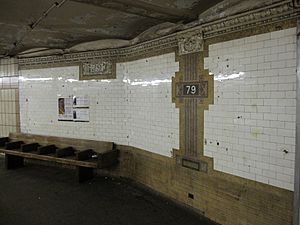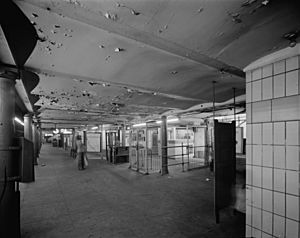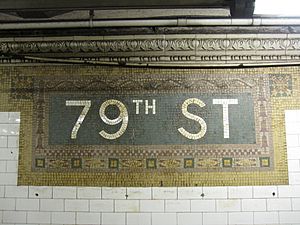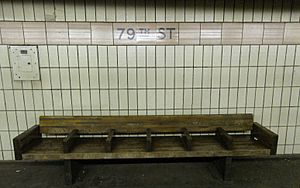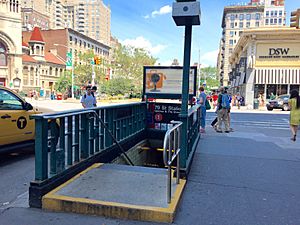79th Street station (IRT Broadway–Seventh Avenue Line) facts for kids
Quick facts for kids
79 Street
|
|||||||||
|---|---|---|---|---|---|---|---|---|---|

View from northbound platform
|
|||||||||
| Station statistics | |||||||||
| Address | West 79th Street & Broadway New York, NY 10024 |
||||||||
| Borough | Manhattan | ||||||||
| Locale | Upper West Side | ||||||||
| Coordinates | 40°47′02″N 73°58′48″W / 40.784°N 73.98°W | ||||||||
| Division | A (IRT) | ||||||||
| Line | IRT Broadway–Seventh Avenue Line | ||||||||
| Services | 1 alltimes (all times) 2 nightsonly (late nights) |
||||||||
| Transit connections | |||||||||
| Structure | Underground | ||||||||
| Platforms | 2 side platforms | ||||||||
| Tracks | 4 | ||||||||
| Other information | |||||||||
| Opened | October 27, 1904 | ||||||||
| Station code | 312 | ||||||||
| Wireless service | |||||||||
| Opposite-direction transfer available | No | ||||||||
| Station succession | |||||||||
| Next north | 86th Street: 1 alltimes 2 nightsonly | ||||||||
| Next south | 72nd Street: 1 alltimes 2 nightsonly | ||||||||
|
|||||||||
|
|||||||||
|
|||||||||
|
|
|||||||||
|
79th Street Subway Station (IRT)
|
|||||||||
| MPS | New York City Subway System MPS | ||||||||
| NRHP reference No. | 04001018 | ||||||||
| Significant dates | |||||||||
| Added to NRHP | September 17, 2004 | ||||||||
The 79th Street subway station is a local stop on the New York City Subway system. It is part of the IRT Broadway–Seventh Avenue Line. You can find it in Manhattan's Upper West Side, at the corner of 79th Street and Broadway.
The 1 train stops here all the time. The 2 train also stops here during late nights. This station was built by the Interborough Rapid Transit Company (IRT). It was part of New York City's very first subway line.
Construction for this part of the subway began on August 22, 1900. The 79th Street station opened on October 27, 1904. It was one of the original 28 stations in the New York City Subway system. Over the years, the station's platforms have been made longer.
The 79th Street station has two side platforms and four tracks. Fast, "express" trains use the middle two tracks to go past the station without stopping. The station was first decorated with tiles and mosaics. However, most of these original designs have been replaced. The station is a New York City designated landmark. It is also listed on the National Register of Historic Places.
Contents
History of the 79th Street Subway Station
Building New York City's First Subway Line
Plans for New York City's first subway line started in 1894. This was when the New York State Legislature passed the Rapid Transit Act. Engineers, led by William Barclay Parsons, designed the subway. Their plan was for a subway line from New York City Hall in lower Manhattan to the Upper West Side. From there, two branches would go north into the Bronx.
A final plan was approved in 1897. Legal issues were sorted out by late 1899. In February 1900, a company called Rapid Transit Construction signed a contract. This company was led by John B. McDonald and funded by August Belmont Jr.. They agreed to build the subway and run it for 50 years. In 1901, the company Heins & LaFarge was chosen to design the underground stations. In April 1902, Belmont started the Interborough Rapid Transit Company (IRT) to operate the subway.
Opening the 79th Street Station
The 79th Street station was part of the IRT's West Side Line. This line is now called the Broadway–Seventh Avenue Line. Construction on this section began on August 22, 1900. William Bradley was in charge of this part of the project.
The 79th Street station opened on October 27, 1904. It was one of the first 28 stations in the New York City Subway. The first subway line ran from City Hall to 145th Street. The opening of this subway line, especially the 79th Street station, helped the Upper West Side grow and develop.
Changes and Upgrades to the Station
After the subway system was finished in 1908, local trains served the station. These trains ran on both the West Side Line and the East Side Line. In 1918, the Broadway–Seventh Avenue Line was extended south. This created an "H" shaped system for the subway lines. All local trains then went to South Ferry.
In 1909, there were too many people using the subway. So, the New York Public Service Commission suggested making station platforms longer. On January 18, 1910, changes were made to the contracts. This allowed platforms to be lengthened for longer trains. About $1.5 million was spent on making platforms longer. Another $500,000 was used to build more entrances and exits. These changes were expected to increase the subway's capacity by 25 percent. Platforms at local stations, like 79th Street, were made about 20 to 30 feet longer. Both the northbound and southbound platforms were extended.
In 1948, new subway cars were introduced. The IRT routes were then given numbers. The Broadway/West Side route became known as the 1 train. The Lenox Avenue route became the 3 train. The original IRT stations north of Times Square were too short for longer trains. So, in the 1950s, platforms from 50th Street to 96th Street were extended. This included the 79th Street station. This project cost $100 million. By early 1958, the platform extensions were finished. After this, all 1 trains became local trains. The 2 and 3 trains became express trains. Longer, eight-car local trains started running. On February 6, 1959, more frequent and longer 1 train service began during busy hours. Because the 86th Street and 96th Street platforms were made longer, the 91st Street station was closed on February 2, 1959. It was too close to the other two stations.
On June 28, 1964, the New York City Transit Authority (NYCTA) hired Delma Engineering Corporation. They were paid $212,874 to build more entrances at the station. This work was still happening in 1967.
In April 1988, the NYCTA planned to make the Broadway–Seventh Avenue Line faster. They wanted to use a skip-stop service with the 9 train. When skip-stop service started in 1989, it was only north of 137th Street–City College on weekdays. The 79th Street station was served by both the 1 and the 9 trains. Skip-stop service ended on May 27, 2005.
In 1979, the New York City Landmarks Preservation Commission named the original part of the station a city landmark. This included the parts built before 1904. The station was one of twelve original IRT stations to get this honor. In 2004, the original inside parts of the station were listed on the National Register of Historic Places.
Station Layout and Design
The 79th Street station is like other local subway stations. It has four tracks and two side platforms. The two express tracks in the middle are used by the 2 train during the day. The 3 train uses them all the time. When the station first opened, the platforms were 200 feet long. After the renovations in 1958–1959, they became 520 feet long. At this spot, the express tracks are a little lower than the local tracks, especially at the north end.
Station Design Features
The subway tunnel is covered by a "U"-shaped structure. This structure holds pipes and wires. The bottom of this structure has a concrete foundation at least 4 inches thick. Each platform is made of 3-inch-thick concrete slabs. These slabs have drains underneath them.
The original platforms have round, cast-iron columns. These columns are spaced every 15 feet. The newer parts of the platforms have I-beam columns. More columns are between the tracks, spaced every 5 feet. These columns hold up the concrete station roofs. The ceiling height changes depending on if there are pipes or wires above. Areas without utilities are about 15 feet above the platform. There is a 1-inch gap between the tunnel wall and the platform walls. The platform walls are made of 4-inch-thick brick covered with tiles.
The areas where you pay your fare are on the same level as the platforms. You cannot cross between platforms underground. The walls near the fare control areas have a brick base. Above this, there are white glass tiles. The platform walls have vertical bands of buff and salmon tiles every 15 feet. These bands are called pilasters. On each pilaster, there are tiled plaques with the number "79" in white on a green background. They also have buff and salmon leaf designs. Above each pilaster are buff-colored plaques with two cornucopias around a shield. A decorative border runs along the top of these walls. Alfred Boote Company did the tile work, and Rookwood Pottery Company did the decorative work. The ceilings in the original platforms and fare control areas have plaster designs. The ceiling north of the fare control area is smooth. The ceiling south of it has curved sections supported by the center columns.
The rest of both platforms have cream-colored tiles. They also have a salmon-colored line with "79TH ST" written in black letters. These tiles were put in during the renovations in the late 1950s.
Station Exits and Entrances
The southbound platform has staff working there. It has turnstiles, a token booth, and a staircase. This staircase goes up to the northwest corner of West 79th Street and Broadway. There is also a walkway separated by a steel fence. This walkway leads to another staircase that goes up to the southwest corner of the intersection. This walkway has a special turnstile that only lets you enter the platform. The walls in this walkway are made of cinder block tiles.
The northbound platform does not have staff. It has turnstiles and a customer assistance booth that is now closed. There is a staircase that goes up to the southeast corner of West 79th Street and Broadway. There is also a walkway with a steel fence. This walkway leads to a staircase that goes up to the northeast corner of the intersection. This walkway has a special turnstile that only lets you exit the platform. The walls in this walkway are made of cinder block tiles. The staircases on the street have simple, modern steel railings. These are like the ones you see at most New York City Subway stations.
- nycsubway.org – IRT West Side Line: 79th Street
- Station Reporter – 1 Train
- Forgotten NY – Original 28 - NYC's First 28 Subway Stations (Part 2)
See also
 In Spanish: Calle 79 (línea de la Séptima Avenida–Broadway) para niños
In Spanish: Calle 79 (línea de la Séptima Avenida–Broadway) para niños





